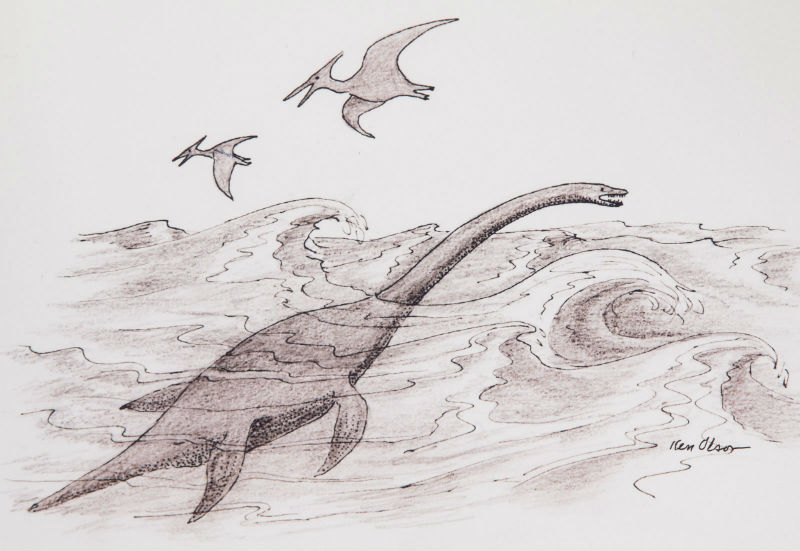 A depiction of a plesiosaur swimming through Montana's ancient sea as flying reptiles soar above the waves.
A depiction of a plesiosaur swimming through Montana's ancient sea as flying reptiles soar above the waves.
Weighing up the evidence
Stones and pebbles are quite rare in the rocks which once made up the seabed. The reptiles must have actively sought out stones, even travelled inland up rivers to find them.
Animals that swim by ‘flying’ under water with wing-like limbs such as extinct plesiosaurs, and penguins and sea lions today, commonly swallow stones. In contrast, animals that swim by undulating the body or tail from side to side such as the ichthyosaurs in the prehistoric food web, or up and down as in seals and dolphins today, typically do not swallow stones. This indicates that there might be a link between gastroliths and particular styles of swimming.
However, many terrestrial (land-living) animals such as the long necked sauropod dinosaurs, swallowed stones, so gastroliths are not necessarily related to swimming. Sauropods used them to help digest the tough plant matter they consumed – but swimming reptiles ate meat.
Some animals without gastroliths had extremely thickened, dense and heavy bone, a condition known as pachyostosis. This controlled their buoyancy by stopping them floating to the surface. This indicates that buoyancy control is a problem for marine animals and gastroliths could be an alternative ballast solution for animals without pachyostotic bones. This is a less demanding (less physiologically expensive) way of attaining negative buoyancy than pachyostosis.
Were stones really heavy enough to make a difference? Where present, gastroliths are usually found in small concentrations although more than 100 are known for some elasmosaurs (very long necked plesiosaurs). Even so, the relative weight of gastroliths to the weight of the body would be insignificant in such large animal.
Conclusion
There is a lot of evidence for and against the three different hypotheses. It is unlikely that gastroliths were swallowed accidentally because it is rare to find stones on the Jurassic sea-bed, yet gastroliths occur frequently, even in animals that do not eat food from the sea floor. It is possible that gastroliths had a dual function, or even different functions in different creatures. Even palaeontologists disagree on the matter; some prefer the idea that they were used for ballast, others that they were used in digestion. Future research may reveal new clues to help us solve this mystery, but for now it remains the ‘riddle of the gastroliths’.
Rate and Review
Rate this article
Review this article
Log into OpenLearn to leave reviews and join in the conversation.
Article reviews